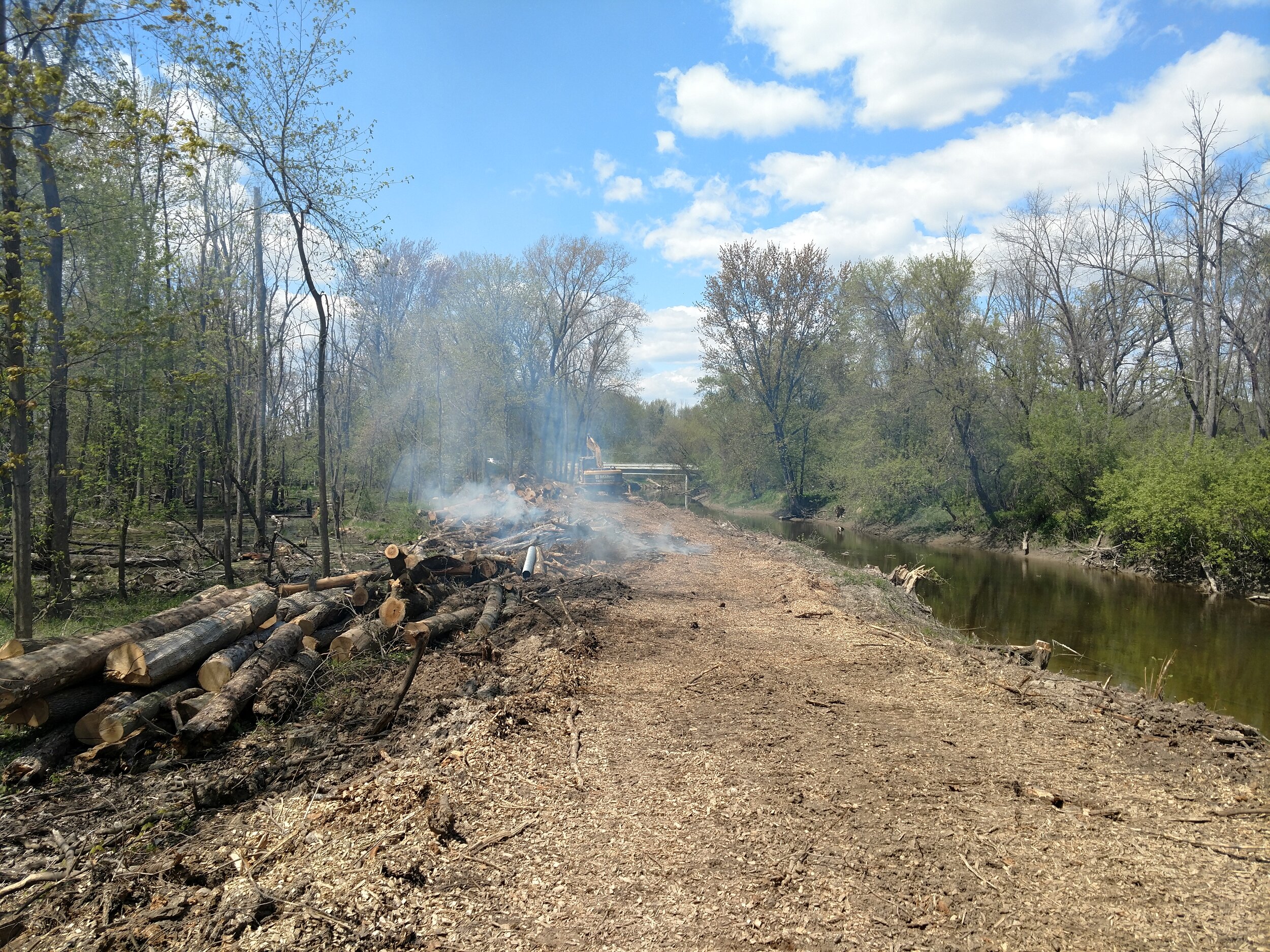Untangling the Jam: How Removing Logs From the Swan Creek Intercounty Drain Improved its Function
Originally established in 1917, the Swan Creek Intercounty Drain (Drain) is an 18.5-mile-long open-channel drain servicing 140 square miles that includes more than 8,000 parcels of land throughout Saginaw, Midland, and Gratiot Counties. It serves as the outlet for 10 intercounty drains and 115 county drains in areas of land that are a mix of residential, agricultural, commercial, and industrial.
Emerald ash borer beetle.
The waters of this long, winding drain outlet into the Shiawassee River including the Shiawassee River State Game Area and Shiawassee River National Wildlife Refuge, the Saginaw River, and eventually, the Saginaw Bay. It travels through multiple municipalities and has direct impact on the water quality of the Great Lakes Bay Region.
In 2013 a complaint was brought forward to the Saginaw County Public Works Commissioner about log jams in the Drain. The emerald ash borer beetle had infested the forested areas along the Drain’s banks and killed thousands of ash trees. These dead trees had then fallen into the Drain and the Jo Intercounty Drain, which was an extension of the Swan Creek Intercounty Drain, causing log jams and blocking the Drain and its right-of-way.
Due to accessibility issues to the drain right-of-way, a visual survey of the 14-mile project was performed by kayak.
“In some areas, the log jams were the size of school buses and endangered surrounding infrastructure such as culverts and bridges,” Spicer Group Project Manager Dave Vallier said. “The blockages were also promoting erosion and sedimentation throughout the Drain.”
With the expectation that the log jams would continue and only get worse, Spicer Group was hired by the Swan Creek Intercounty Drainage Board (SCIDB) to develop a preliminary maintenance plan of action. At the direction of the SCIDB, Spicer Group’s team reviewed historic documents, did a preliminary assessment, reviewed access to the drain, and field reviewed the condition of the Swan Creek and Jo Intercounty Drains.
Vallier said the team identified areas of significant debris and log jams at more than 50 locations along both drains, sediment bars that had built up at more than 20 locations, and erosion along portions of the drains at multiple locations.
“The log jams that were observed were massive. Decades-old trees crossed the channel at multiple points, blocking flow,” Vallier said. “The sediment bars were big enough for inspectors to walk out onto, and the banks were severely eroded and dangerous.”
In 2017, after a petition was filed by Thomas Township with the Saginaw County Public Works Commissioner, the SCIDB found it necessary to consolidate the Swan Creek Intercounty Drain and Jo Intercounty Drain and complete a large-scale comprehensive improvement project along the entire length of the Drain.
During the preliminary engineering phase of the project, the SCIDB conducted the process under Section 197 of the Michigan Drain Code to revise all the drainage boundaries for each drain – all 125 of them – within the watershed.
Spicer Group and the SCIDB used LiDAR technology to perform this task quicker, safer, and more efficiently than traditional surveying methods. Using LiDAR data layered digitally on top of existing drainage boundaries, engineers were able to view where the boundary lines were and adjust where necessary. These were then field checked for accuracy.
A document of all the easements was assembled to allow the drainage board to record the necessary easements. Through this complex process, the Swan Creek and Jo Drains were consolidated. After consolidation, the Swan Creek remained an inter-county drain. The Jo Drain is now an 11.5-mile-long intra-county drain that is only in Midland County.
“During the project, representatives met with landowners throughout the district to discuss the project details and acquire permanent or temporary ingress / egress easements to access the Drain right-of-way for construction,” Vallier said. “Access to the Drain right-of-way was very limited due to high drain banks, length of guardrails at all road crossings, and the residential and commercial development that has taken place since the Swan Creek Drain was established in 1917.”
Construction on the project began in January of 2019.
Trees were removed along the Swan Creek Drain to create a 20-foot-wide maintenance access lane.
Along the length of the Swan Creek Intercounty Drain, dead trees were removed from its right-of-way to create a minimum 20-foot-wide maintenance access lane. All dead ash trees, standing or fallen were topped, cut, and left for landowners who wanted the wood. The remaining was chipped or burned and buried. Chipped debris was then spread along the maintenance lane.
Removing these enormous logs reduced the likelihood of bridge failure and prevents further damage. It also provides flood protection, reduces the likelihood of major erosion, and allows for easier future access and maintenance.
Another portion of the improvement project included removing sediment bars and restoring the severely eroded banks. Rip rap and erosion control blankets were installed to stabilize eroded banks and to prevent further erosion. This improved the quality of the stream and the ease of flow for numerous other county drains that outlet into the Swan Creek Intercounty Drain.
The removal of the dead ash trees and obstructions has allowed the new meandering low-flow channel to re-establish and since the completion of the project there is evidence of the forming of a natural two-stage channel in sections of the Drain.
Additionally, the contractor’s crews focused on leaving many live, healthy trees along the maintenance path to maintain the natural aesthetic beauty of the watershed.
There were more than 8,000 parcels of land assessed by the SCIDB for this project. Because of the size of the district and the number of parcels to be assessed, it made the one-time improvement project extremely cost effective and efficient to complete the work throughout the length of the Drain versus doing a maintenance project on smaller portions for the next 20 years.
Post-construction view of the Swan Creek Intercounty Drain, with a maintenance lane created and riprap installed.
“The SCIDB developed an innovative project that can be used as a model for other county drains on how to research, facilitate, design, fund, and implement larger construction projects needed to clear drains devastated by dead ash trees,” Vallier said.
This model provides examples on how to develop drainage district maps effectively and efficiently using a combination of historical and new LiDAR technology data, then fairly assess those land parcels within the drainage district to fund a cost-effective construction project rather than stretch a drain improvement project out for decades under the maintenance allowance.





